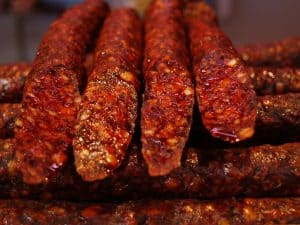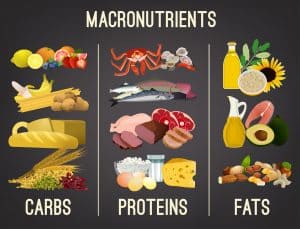I was determined to get ripped—working myself like an absolute monster in each training session.
The problem was—one day in the gym meant two to three days of recovery. My aching muscles were preventing me from returning to the weights as soon as I’d like.
This was hampering my workout regime. I knew unless I addressed the issue—I was never going to achieve the physique I desired.
Thankfully, I found the answer.
Here’s why muscle soreness occurs—and how to alleviate it.
What Causes Muscle Soreness After Workouts?
If you’ve pushed yourself hard lifting, pounding the concrete or cycling—at some time you’ll have experienced post-training soreness.
Not only do the muscles hurt like crazy when touched—it’s as if they’ve decided to go on strike. Walking down stairs, climbing into the shower and even lifting your cup of morning Joe, can be an immense and jelly-like effort.
So, what’s causing this incapacitating condition?
Usually, post-training pain is known as DOMS (delayed-onset muscle soreness). This condition lasts for a period of 24-72 hours after workouts.
While the causes are still not fully understood—it’s believed that eccentric exercise (which lengthens the muscles) causes small tears (microtrauma) to the muscle tissues.
In response, calcium (Ca)—usually stored in the sarcoplasmic reticulum—begins to gather in the muscles. This inhibits cellular respiration which further prevents ATP (adenosine triphosphate) from removing the Ca.
This calcium accumulation stimulates phospholipases and proteases—which begin to break down muscle proteins. As a response, inflammation elevates which induces pain.
Furthermore, potassium, histamines, and prostaglandins build-up, which can increase soreness even further. And that, buddy, is DOMS.
Let me put one belief to bed.
Guys down the gym may tell you that DOMS results from the amassing of lactic acid in the muscles.
This is completely incorrect.
Firstly, concentric contractions (shortening of the muscle)—which also produces lactic acid—don’t induce DOMS. Secondly, research shows that lactic acid returns to normal levels around one hour post-training—it doesn’t hang around for two to three days.
Muscle Soreness Factors

I’m sure you’ve also worked out like a beast in the past and still felt no ill-effects the following day. That’s because DOMS is dependent on:
1
Frequency of Training
If you’re new to training or exercise—or have introduced some new elements to your routine, you’re more likely to experience DOMS.
Over time, the tears introduced to the muscles build and repair—making them stronger and able to withstand the pressures of working out.
But, start pushing a new muscle or in a different manner, and your body hasn’t had time to become accustomed to this.
2
Exercise Intensity
In a similar way, working the muscles past their “usual” limits—has the same effect.
Even if you’ve been knocking out three sets of biceps curls a day—increasing the weight loading or reps pushes the muscles harder and causes microtrauma.
3
Type of Exercise
As mentioned, DOMS is the result of eccentric and not concentric exercise.
That is, when muscles are lengthened in a controlled manner in resistance to weight (whether heavy iron or just your body weight).
Hence in a bicep curl, purely completing the upward movement of the dumbbell toward the shoulder only will not promote DOMS. However, the lowering of the dumbbell is eccentric—as the muscles are extending and can cause soreness.
4
Estrogen Levels
Research illustrates that estrogen protects muscles, promotes rebuilding and encourages regeneration.
Hence, if you’re a guy completing eccentric exercises alongside a female buddy—you have a higher chance of being sore the next day than her.
Is Muscle Soreness an Indication of a Good Workout?
This depends on the reason for your pain, its extent, and how it affects your day-to-day routine.
Firstly, so far in this article, we’ve been looking at DOMS—the most common form of post-exercise muscle discomfort. However, you should also be aware that there is another type called immediate (or acute) muscle soreness.
Typically, this arises with a few minutes of completing exercise and can last up to several hours later.
This can be caused by:
- Accumulation of chemical and waste products of the exercise process.
- Tissue edema.
- Muscle fatigue—they simply cannot work anymore.
Yet, both immediate and delayed muscle soreness may be mistaken for a more severe cause—injury.
And definitely not the sign of a good workout.
Tears and strains to ligaments, tendons, and muscles are common with intense exercise. Signs that your muscle soreness is an indicator of damage and not DOMS are:
- Swelling of the affected area.
- Change in color—especially evidence of black or blue bruising.
- Pain which either doesn’t alleviate or becomes worse over 72 hours.
- Soreness that is intense, even when at rest.
- Sharp, stabbing pains.
- Feeling nauseous or uncomfortable.
- Numbness or tingling.
- Loss of function to the affected area.
In these circumstances—it’s advisable to consult with your health practitioner.

However, let’s drop the negatives for a second.
Feeling some pain and a little discomfort post-exercise can be a positive sign. My advice is this—welcome DOMS. It’s a sign that you’ve been pushing yourself hard and the body is rebuilding.
Which means growth to muscle and enhanced cardiovascular fitness.
However, if the pain lasts more than two to three days—or it’s affecting your day to day routine—it can have negative effects.
Most obviously, being in great discomfort and unable to move the affected muscle(s) sufficiently can hinder future workouts. Or, put them completely on the back burner. Hence, restricting your fitness or bodybuilding progress.
Secondly, in addition to your gym-enhancing energy expenditure—you’re keeping your fitness levels elevated by fulfilling daily tasks. Known as NEAT (non-exercise activity thermogenesis) you burn calories through everyday routines such as gardening, working, grocery-shopping and doing the chores.
These normal practices can keep the weight off and boost cardio health. But, if DOMS is preventing you from sufficiently completing these tasks—you’re impeding on your own progress.
The bottom line:
Some pain after exercise is good—you’ve worked hard! But, if it has a detrimental effect on future training or your daily life—you’ve pushed yourself too far.
Should You Workout With Sore Muscles? Will It Interrupt the Muscle Repair Process?

Naturally, if the muscle soreness you experience is due to an injury—the affected areas shouldn’t be trained. That is, unless on advice from your doctor or physiotherapist.
But, assuming it’s DOMS and nothing more serious—should you train?
This depends on the level of pain.
Sometimes, heavily-worked muscles feel a little tender, but there’s no evidential swelling—it just appears and feels harder than usual.
Alternatively, soreness can be debilitating—restricting your strength, power and range of movement.
So, be sensible, buddy.
Where muscle pain is slight—a 2003 study shows that working the affected area provides an analgesic effect—lowering discomfort. Furthermore, exercise elevates blood flow to the muscles—which will help them to repair and build.
This same clinical study explains that while working the painful area is beneficial—intensity and duration of training should be reduced from your “regular” level. This allows your body to both rehabilitate the muscles and reduce the likelihood of serious injury.
Conversely, if muscle pain is severe and restricting—rest the particular area.
This, however, doesn’t mean putting up your feet for the next week. For example, your biceps may be recuperating—but this does not affect your ability to work the legs or abdominals.
Not only does this prevent your overall training progress suffering—it will still boost cardiovascular activity and promote healing.
Myths About Muscle Soreness
Gym and locker-room speak all provide their own theories about muscle soreness—here are the three most popular myths:
1
Only Unfit People Suffer from DOMS
It’s a fact that more experienced athletes experience less muscle soreness—as their bodies have already become accustomed to the stresses of running or lifting.
However, even these men and women can succumb to post-exercise pain if they push their bodies past what is considered “normal.”
Furthermore, research tells us that certain people are genetically disposed to experiencing muscle pain and require longer recovery times than those with a more beneficial genome.
2
Post Exercise Muscle Soreness Is Caused by Lactic Acid
While lactic acid may cause some of the pain during exercise—the body quickly expels it and it’s not responsible for DOMS.
Instead, it’s believed to be an accumulation of exercise by-products and inflammation.
3
If You Don’t Hurt the Next Day—Your Workout Was Too Easy
No pain, no gain. Right?
Apparently not. Research from Northern Arizona University has illustrated that muscle hypertrophy (growth) is independent of either serious muscle damage or post-training soreness.
While those experiencing DOMS may show mass improvements or increased tone—it’s not a prerequisite.
How to Get Rid of Muscle Soreness

Reducing the impact of muscle soreness means both taking steps to prevent its occurrence in the first place, and being able to alleviate the symptoms should you push yourself too hard while training.
Here are my top seven tips to keeping muscle pain at bay:
1
Foam Rolling
These cylindrical and lightweight pieces of foam allow you to perform self-myofascial release on tight muscles—immediately after your workout.
Useable on all parts of the body—this simple piece of equipment rolls, massages and compresses muscle tissue-stimulating blood flow, increasing flexibility and boosting repair.
Research shows that foam rollers have no harmful effects and provide relief from DOMS.
2
Consume Food After Exercise
Muscles are drained of vital nutrients during intense exercise—replenishing their reserves can help to prevent the onset of muscle pain.
Consuming foods (or shakes) high in protein not only stimulates muscle growth post-training, but can also lower the soreness inducing inflammation of DOMS.
3
Bathe In Epsom Salts
Studies show that applying heat to muscles that are suffering from DOMS can increase their rate of recovery, preserve their strength and reduces soreness.
Hence, taking an indulging hot bath post-workout is the simplest way to treat the entire body.
Furthermore, you can accentuate these healing benefits by mixing magnesium sulfate (Epsom salts) into the bathwater. Scientists explain that it’s possible for the body to absorb magnesium transdermally—that is, being soaked up through the skin.
This mineral is a proven anti-inflammatory—therefore removing DOMS discomfort.
4
Stretch Before And After Exercise
A recent study indicates that stretching pre and post-workout can lower DOMS symptoms.
Furthermore, the benefits of these muscle-lengthening techniques continue to provide relief for up to three days post stretching.
However, scientists agree that while effective, the results were not dramatic enough to prove entirely conclusive—with more research being required.

5
Get Plenty of Sleep
If you want to recover fast and reduce the chances of DOMS—cut back on the all-nighters.
Experts tell us that interrupted or lack of sleep is severely damaging to our recovery. This is because it:
- Raises blood pressure.
- Increases production of the catabolic (muscle-destroying) hormone cortisol.
- Lowers formation of the mass-building steroid testosterone.
- Impedes the creation of the muscle powering IGF-1 (insulin-like growth factor 1).
More specifically, a 2019 study examined the effects of grounded sleeping (where the participants are earthed during slumber) on 22 healthy subjects undergoing eccentric training.
The results illustrate that sleeping, especially when earthed, accelerates the healing process and reduces the chance of developing DOMS.
And, don’t think you have to be a scientist or an electrician to take advantage of this discovery—grounded sleeping mats are readily available over the counter.
6
Low Intensity-Cardio Exercise
Taking it steady on the treadmill or elliptical may not provide you with a shredded physique—but it’s a powerful tool for muscle recovery.
Any exercise which increases the heart rate elevates blood flow, muscle function and waste-product removal. Furthermore, utilizing low-intensity cardio keeps you flexible.
Studies show that this so-called active recovery is a proven way to lower muscular pain.
7
Be Sensible With Your Workouts
Planning your workouts can enable you to reduce the chance of developing muscle soreness.
Obviously, we all want to push ourselves—it’s the only way to make both muscle and fitness gains—but take it steady.
When formulating your training regime, ensure that you:
- Take it easy on new muscle groups—if you haven’t worked particular muscles for an extended period of time (leg day, anyone?)—start with lighter weights.
- Make steady increases—whether lifting, running or cycling—increase your intensity a little at a time in each workout—not massive leaps.
- Try to avoid working the same muscles on consecutive days—this can increase their stress and contribute to developing DOMS.
The Takeaway
We’ve all felt the pain post-training.
In fact, sometimes we welcome it—a sign that we’ve taken our workouts to the absolute max the previous day.
But, research shows that you don’t have to push your body so far that you’re in pain for 72 hours in order to reap impressive workout rewards.
Following the advice in this article can help you obtain the ripped physique you’re chasing—but, without suffering afterward.













